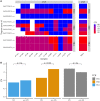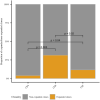Copy number variations across the blood-brain barrier in multiple sclerosis
- PMID: 35560551
- PMCID: PMC9268884
- DOI: 10.1002/acn3.51573
Copy number variations across the blood-brain barrier in multiple sclerosis
Abstract
Objective: Multiple sclerosis (MS) is a neuroinflammatory disease where immune cells cross the blood-brain barrier (BBB) into the central nervous system (CNS). What predisposes these immune cells to cross the BBB is still unknown. Here, we examine the possibility that genomic rearrangements could predisposespecific immune cells in the peripheral blood to cross the BBB and form sub-populations of cells involved in the inflammatory process in the CNS.
Methods: We compared copy number variations in paired peripheral blood mononuclear cells (PBMCs) and cerebrospinal fluid (CSF) cells from MS patients. Thereafter, using next generation sequencing, we studied the T-cell receptor beta (TRB) locus rearrangements and profiled the αβ T cell repertoire in peripheral CD4+ and CD8+ T cells and in the CSF.
Results: We identified deletions in the T-cell receptor alpha/delta (TRA/D), gamma (TRG), and TRB loci in CSF cells compared to PBMCs. Further characterization revealed diversity of the TRB locus which was used to describe the character and clonal expansion of T cells in the CNS. T-cell repertoire profiling from either side of the BBB concluded that the most frequent clones in the CSF samples are unique to an individual. Furthermore, we observed a difference in the proportion of expanded T-cell clones when comparing samples from MS patients in relapse and remission with opposite trends in CSF and peripheral blood.
Interpretation: This study provides a characterization of the T cells in the CSF and might indicate a role of expanded clones in MS pathogenicity.
© 2022 The Authors. Annals of Clinical and Translational Neurology published by Wiley Periodicals LLC on behalf of American Neurological Association.
Conflict of interest statement
No author has any conflict of interest related to this study to report.
Figures







Similar articles
-
TCR repertoire diversity in Multiple Sclerosis: High-dimensional bioinformatics analysis of sequences from brain, cerebrospinal fluid and peripheral blood.EBioMedicine. 2021 Jun;68:103429. doi: 10.1016/j.ebiom.2021.103429. Epub 2021 Jun 11. EBioMedicine. 2021. PMID: 34127432 Free PMC article.
-
Human CD4+ T cell subsets differ in their abilities to cross endothelial and epithelial brain barriers in vitro.Fluids Barriers CNS. 2020 Feb 3;17(1):3. doi: 10.1186/s12987-019-0165-2. Fluids Barriers CNS. 2020. PMID: 32008573 Free PMC article.
-
Single-cell analysis reveals expanded CD8+ GZMK high T cells in CSF and shared peripheral clones in sporadic amyotrophic lateral sclerosis.Brain Commun. 2024 Nov 27;6(6):fcae428. doi: 10.1093/braincomms/fcae428. eCollection 2024. Brain Commun. 2024. PMID: 39659975 Free PMC article.
-
Studies on activation variables in multiple sclerosis.Acta Neurol Scand Suppl. 1988;115:1-103. Acta Neurol Scand Suppl. 1988. PMID: 2838999 Review.
-
How Does the Immune System Enter the Brain?Front Immunol. 2022 Feb 22;13:805657. doi: 10.3389/fimmu.2022.805657. eCollection 2022. Front Immunol. 2022. PMID: 35273596 Free PMC article. Review.
Cited by
-
Broader Epstein-Barr virus-specific T cell receptor repertoire in patients with multiple sclerosis.J Exp Med. 2022 Nov 7;219(11):e20220650. doi: 10.1084/jem.20220650. Epub 2022 Sep 1. J Exp Med. 2022. PMID: 36048016 Free PMC article.
References
Publication types
MeSH terms
Substances
LinkOut - more resources
Full Text Sources
Medical
Research Materials
